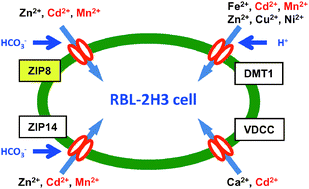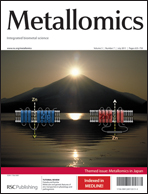Cellular incorporation of Cd involves multiple transport systems for other metals such as Fe, Zn, Mn, and Ca. Metal transporters including divalent metal transporter 1, Zrt/Irt-related protein (ZIP) 8, and ZIP14, and certain types of voltage-dependent Ca channels have been shown to be involved in cellular Cd uptake. However, tissue- or cell-specific roles of these metal transporters in the accumulation and toxicity of Cd remains unclear. In the present study, we compared the sensitivity to and accumulation of Cd, Mn, and Zn among four types of rat cell lines. Rat basophilic leukemia RBL-2H3 cells showed the highest sensitivity to Cd and Mn due to the highest accumulation of Cd and Mn among the four cell lines. The high accumulation of Cd and Mn was caused by high uptake rates of Cd and Mn. Since relatively high expression of ZIP8 and ZIP14 was found in RBL-2H3 cells, siRNAs of ZIP8 and ZIP14 were transfected into RBL-2H3 cells. The knockdown of ZIP8, but not of ZIP14, significantly reduced the uptake rates of Cd and Mn in RBL-2H3 cells, especially in the presence of bicarbonate. These results suggest that the high expression of ZIP8, which is known to have affinities for both Cd and Mn, resulted in high accumulation of Cd and Mn, leading to high sensitivity to these metals in RBL-2H3 cells. Thus, RBL-2H3 cells may serve as a good model for clarifying the mechanisms of Cd and Mn transportviaZIP8.


 Please wait while we load your content...
Please wait while we load your content...